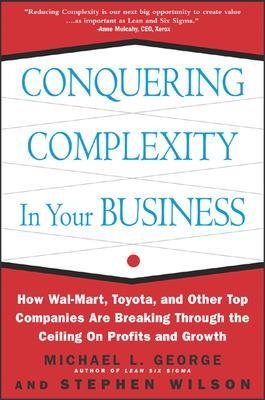
Conquering Complexity in Your Business: How Wal-Mart, Toyota, and Other Top Companies Are Breaking Through the Ceiling on Profits and Growth
McGraw-Hill Professional (Verlag)
978-0-07-143508-6 (ISBN)
- Titel z.Zt. nicht lieferbar
- Versandkostenfrei
- Auch auf Rechnung
- Artikel merken
'The winners and losers in the next decade...may well be separated by a single factor: those that conquer complexity and those that do not' - Michael L. George and Stephen A. Wilson. Here's a guarantee: Somewhere in your business, there is too much complexity. It erodes profitability, impedes productivity, confuses customers, and adds non-recoverable costs that can kill you in the marketplace. But that's only half the equation: You may also be losing out by having too little of the complexity where it counts - in the products, services, and options you offer to customers. Customers call this value-added complexity "variety", "options", or "customization". Either way, as you'll discover in "Conquering Complexity in Your Business", the impact of complexity is enormous in terms of lost profit and missed growth opportunities.In this breakthrough book from Michael L. George and Stephen A. Wilson, you'll find out why the trick to outperforming your competition and staying ahead of the curve in today's highly customer-centric business environment is achieving the optimum levels of complexity in your products, services, and operations.
Best of all, for the first time in print, you'll find powerful tools that will let you quantify and pinpoint complexity in your business. You'll also find strategies for conquering that complexity and dramatically increasing productivity, profits and market share. "Conquering Complexity in Your Business" is packed with real-world practical advice and guidance from both a strategic and tactical perspective. With the help of fascinating and instructive in-depth case studies from Dell, Capital One, Southwest Airlines, Wal-Mart, Toyota, Scania, Lockheed Martin, Aldi, and other companies that have conquered complexity to become world leaders in their industries, the authors show you how to: strategically identify the offering and process complexity in your business; quantify the impact of that complexity; decide which complexity you want to keep to drive growth and which to eliminate to cut costs; select and implement specific operational approaches to eliminate different kinds of complexity; and, sustain an environment with just the right balance of complexity your company needs to maximize productivity and profits.Don't let complexity impose a ceiling on your profits and growth.
Read "Conquering Complexity in Your Business" and learn how to serve your customers more effectively, dominate your competition, and delight your shareholders. 'This is an important book that should be read by every CEO. "Conquering Complexity" is not just about reducing costs; it's fundamentally about growing revenues and creating economic value by serving your customers more effectively' - Lou Giuliano, Chairman, President and CEO, ITT Industries. 'Complexity creeps into organizations incrementally, and each additional decision is, by itself, almost always justifiable. But faced with a crisis, many companies, including American Airlines, have chosen a head-on approach to removing complexity - we simply could not afford to do otherwise' - Gerard J. Arpey, President and CEO, AMR Corporation and American Airlines.'As we tackle the most resistant issues in the company, it is clear that complexity is a key causal. The challenge is getting our arms around the cost of complexity. Being able to size the opportunity creates a compelling call to action' - Anne M.Mulcahy, Chairman and CEO, Xerox Corporation.
'It is critical that the authors' study and analysis gets outs to a wider audience to explain how complexity occurs and more importantly, how to both attack it and prevent it' - Chris Cool, Vice President, Northrup-Grumman Corporation.Many managers and executives intuitively understand that the benefits from conquering complexity can be huge. But only a handful worldwide know to how to precisely measure, manage, and profit from complexity. Now, with "Conquering Complexity in Your Business", a breakthrough book from complexity gurus Michael L. George and Stephen A. Wilson, all of that changes. Learn how to break through the ceiling on your company's profits and growth.
McGraw-Hill authors represent the leading experts in their fields and are dedicated to improving the lives, careers, and interests of readers worldwide McGraw-Hill authors represent the leading experts in their fields and are dedicated to improving the lives, careers, and interests of readers worldwide
Preface
Part I Complexity: The Silent Killer of Profits and Growth
Chapter 1 The Overwhelming Case for Conquering Complexity
A Tale of Two Companies
The Three Rules of Complexity
Complexity Rule #1: Eliminate complexity that customers will not pay for
Case #1: The story of Southwest Airlines vs. American Airlines
Complexity Rule #2: Exploit the complexity customers will pay for
Case #2: Capital One vs. MBNA, Bank of America, et al
Complexity Rule #3: Minimize the costs of complexity you offer
Case #3: The real secret of Toyota
Case #4: Experience bought, not taught
Finding the Right Combination of External and Internal Complexity
The Complexity Value Proposition
Conclusion: The competitive advantage of conquering complexity
Chapter 2 Exposing the Silent Killer: How (and how much) complexity drains time and resources in your business
How Complexity Silently Kills Profits and Drains Resources
Process Cycle Efficiency: The foundation for quantifying complexity
Quantifying What Affects PCE: The Complexity Equation
How Variation in Mix Destroys PCE and Profit
What Lever to Pull?: Advice on improving PCE
The Power of Numbers
Conclusion
Chapter 3 How Complexity Slows the Flow of Critical Information
Information Flow Complexity = Too Long to Reach Decision Makers
Complexity Creates Noise in Information Systems
Dell and Compaq: Better to be fast than first
How Does Dell Achieve Fast Information Flow?
Conclusion: Cumulative effect of complexity on strategic decision making
Chapter 4 How Conquering Complexity Drives Shareholder Value
The Challenges of Accounting for Complexity
Making Decisions That Benefit Shareholders: Earnings Per Share vs. Economic Profit
Key Lessons About EP and Growth
The Complexity Imperative in Fast Markets
The Links between Complexity and Value
Conclusion
Chapter 5 Complexity as a Strategic Weapon
Six Precepts For Strategic Use of Complexity
Precept #1: Customers define value
Precept #2: The biggest gains from conquering complexity come from step-change improvements
Precept #3: Focus on what matters most—100% of your value creation probably resides in only 20% to 50% of offerings
Precept #4: Think value share instead of market share
Precept #5: Growth results from value-driven application of finite resources
Precept #6: First eliminate offerings that can never generate positive Economic Profit, then attack internal complexity
ALDI International: A case study in strategic complexity
Eating Away the Competition
ALDI’s Secret of Success: Eternal watch against complexity
Conclusion (and a look ahead)
Part II Complexity Analysis: Quantifying and Prioritizing Your Complexity Opportunities
Executive Overview of Complexity Analysis
Chapter 6 Identify Strategic Complexity Targets (Complexity Analysis Phase 1)
Overview of Target Selection
Step 1: Identify areas of greatest value-at-stake
Data You’ll Need to Identify Value-at-Stake
Interpreting Economic Profit
Getting More From Your Waterfall Chart
Step 2: Analyze the strategic position of selected value-at-stake units
Data You’ll Need to Evaluate Strategic Position
Using and Interpreting Strategic Position Data
Mining Market Profitability and Competitive Position Data
Outcome of Strategic Analysis
Step 3: Develop a Complexity Profile of selected business units
Data You’ll Need for a Complexity Profile
Charting and Interpreting a Complexity Profile
What You Can Learn From a Complexity Profile
Summarizing Phase 1 Lessons: Sources of exploitable advantage
Conclusion
Chapter 7 Map & Quantify the Impact of Complexity (Complexity Analysis Phase 2)
Overview of Mapping Complexity & Quantifying Impact
Step 4: Identify the strategic value of your core processes
EGI Case Study, Part 1: Core Process Analysis
Step 5:. Determine family groupings
EGI Case Study, Part 2: Identifying product families
Step 6: Create a Complexity Value Stream Map
EGI Case Study, Part 3: CVSM
Step 7: Computing PCE baselines
Data You’ll Need to Compute PCE Baselines
Calculating PCE Baselines: EGI example
Conclusion
Chapter 8 Build a Complexity Value Agenda (Complexity Analysis Phase 3)
Overview of Developing a Complexity Value Agenda
Step 8: Calculate EP% for offerings
Data You’ll Need to Calculate EP% by Offering
Step 9: Perform a substructure analysis
Data You’ll Need to Perform a Substructure Analysis
Interpreting a Substructure Analysis
Step 10: Calculate PCE Destruction and complete a Complexity Matrix
Data You’ll Need for PCE Destruction and the Complexity Matrix
Completing and Interpreting a Complexity Matrix
Step 11: Evaluate potential impact of process or offering changes
Path A: Value creation from process improvement
Path B: Value creation from offering improvement
Adding Numbers to the Options: What-If analyses with the Complexity Equation
Step 12: Select options and build business cases for selected opportunities
Step 13: Create a Complexity Value Agenda (and Execute!)
The EGI Case Study: Prioritizing and Building a Value Agenda
Conclusion
Part III Implementing Complexity Agendas
Chapter 9 Simplifying Product and Service Lines Going for Big Gains in Economic Profit
The Pricing Lever
Simplifying Product or Service Configurations: Exploiting naturally occurring configurations
Adjusting Your Customer Portfolio
Options for Deletion of a Product or Service
Managing Deletions
Roadblocks to Simplification
Conclusion: Biting the simplification bullet
Chapter 10 Finding the Complexity That Customers Value
A Case Study in Choice Explosion
What Customers Want vs. What They Value
Technique #1: Key Buying Factor analysis
Technique #2: Kano analysis
Technique #3: Functional analysis
Technique #4: Conjoint analysis
Conclusion: Considering complexity when developing customer-focused strategies
Chapter 11 Avoiding the Big Costs Using Complexity Principles to Simplify Product Designs
Simplicity Principle #1: Emphasize commonality
A. Commonality Through Modularization
B. Commonality Through Platforms
Case Study: IPM’s applications of platform thinking
Benefits of Commonality
Simplicity Principle #2: Exploit design reuse/recycling
Simplicity Principle #3: Design with the life cycle in mind
Benefits of Life Cycle Planning and Execution
Example: Simplifying brake design in bikes
Improving Design-to-Market Cycle Time
Conclusion: Start with the end in mind
Chapter 12 Achieving Service and Process Simplicity Optimizing work flow with Lean, Six Sigma, and complexity tools
Complexity and Waste
Approach #1: Exploit commonality to reduce duplicative effort
Approach #2: Ensure standardization of tasks
Approach #3: Eliminate the delays and impact of task startup and task switching
The Four Step Rapid Setup Method
Conclusion
Chapter 13 Using Information Technology to Deliver Complexity at Lower Cost
Using IT to Deliver Variety (Good Complexity) at Low Cost
The Cost of IT Complexity
Fighting Back Against IT Complexity
Principle #1: Don’t rely on IT to fix a broken process (it won’t!)
Principle #2: Reduce the complexity in your systems architecture (because your customers won’t pay for it!)
Principle #3: Outsource complexity where strategically desirable
Principle #4: Use modularity in your hardware and software
Conclusion
Part IV High-Return Investments When Conquering Complexity
Chapter 14 Creating a Culture that Can Conquer Complexity
Cultural Ingredient #1: Believe conquering complexity is an imperative
Cultural Ingredient #2: Ongoing executive engagement
Cultural Ingredient #3: Target high value-at-stake opportunities
Cultural Ingredient #4: Dedicate organizational resources
Cultural Ingredient #5: Provide an analytical methodology and toolset
Cultural Ingredient #6: Align metrics, incentives, policies with complexity goals
Cultural Ingredient #7: Nurture close customer connections
Conclusion
Chapter 15 Conquering Complexity in Your Product and Service Value Chain
Value Chain Configuration: Extracting the full value from conquering complexity
Strategic Sourcing: How complexity drives the make-or-buy decision
Managing Upstream Complexity: Strategic supplier segmentation
Planning for Value Chain Changes
Downstream Complexity: Smashing the retail paradigms
Conclusion
Chapter 16 Applying Complexity Principles to Mergers and Acquisitions
Complexity Due Diligence
Win the Deal, Lose the Synergies
Addressing Complexity Can Accelerate Integration
Making Complexity Due Diligence (and M&A) a Repeatable Process
Conclusion
Appendix
Index
| Erscheint lt. Verlag | 16.8.2004 |
|---|---|
| Sprache | englisch |
| Maße | 160 x 236 mm |
| Gewicht | 643 g |
| Themenwelt | Wirtschaft ► Betriebswirtschaft / Management ► Finanzierung |
| ISBN-10 | 0-07-143508-5 / 0071435085 |
| ISBN-13 | 978-0-07-143508-6 / 9780071435086 |
| Zustand | Neuware |
| Haben Sie eine Frage zum Produkt? |
aus dem Bereich


